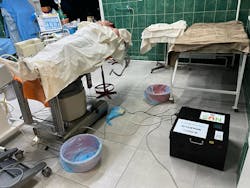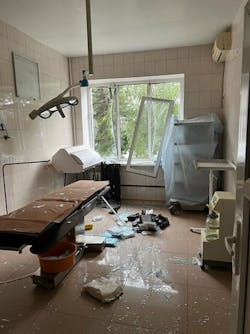Portable Solar Microgrids are “Magic Boxes” for Ukrainians Struggling to Power Critical Facilities
In the war-torn Donbas region of Ukraine, a medic tended to soldiers' wounds in a small clinic.
Unreliable fossil-fueled generators frequently halted his medical work. But SmartAid, a disaster relief organization, and New Use Energy stepped in, providing portable solar microgrids.
Once this technology was installed and restored electricity, the medic proclaimed the microgrid a "magic box" in a YouTube video. And so the 2.5-kWh solar generator – with a 1,500-watt inverter, housed in a sturdy metal case – gained a nickname.
"It was an honor to have such a brave man nickname it like that, so we kept the name in his honor," said Paul Shmotolokha, CEO of New Use Energy, during a teleconference about Ukraine organized by New Use Energy.
Solar systems serving mission critical role for Ukraine's strained health care facilities
The company’s solar generators are operating in over 20 hospitals and field hospitals in Ukraine, he said. They generally include 5 kW-6kW of solar plus 5 kWh of storage.
Solar generators not only help refrigerate medicine and provide lighting in hospitals, but they also reduce dependence on expensive diesel fuel and don’t spew air pollution. Diesel also must be transported and delivered over supply routes vulnerable to Russian attack.
In addition, the on-site power systems provide security, said Shmotolokha, who is Ukrainian-American. Operators of Russian drones can detect the heat signatures and hear the noise emitted by fossil generators, but the solar generators can’t be detected by drones, he said.
Solar generators also are less likely to break down, according to reports there.
“People tell me there are even large piles of broken [fossil-fired] generators because they run so much and they’re in tough operating conditions,” he said.
Dmytro Fedorenko, head of the intensive care unit at Mykolaiv Oblast Hospital in Mykolaiv and a regional head in the field of anesthesiology, echoed Shmotolokha's observations during the teleconference.
Solar microgrids are providing a reliable power source, protecting patients' lives and alleviating the hospital's dependence on diesel, which often runs short during power outages. The solar generators not only ensure the smooth running of medical equipment but also come as a relief to a budget-strained hospital, providing free, sustainable electricity, he said.
"We don't have to pay for power--that's so awesome," Fedorenko said. "Consistent, undisrupted power is the most important component for the successful work in our unit, successful results for our patients and their life,” he said.
While the solar generators have been important to hospitals and medical clinics across Ukraine, their influence is farther reaching.
For example, the solar generators have been deployed in the wake of the destruction of the Kakhovka Dam on the front lines of the war. On June 6, the Kakhovka Dam was blown up, causing the reservoir’s water to flood into the Dnipro River, over its banks and through Kherson, Ukraine.
During the teleconference, Halyna Luhova, city councilwoman and former mayor of Kherson, described the loss of power because of the flooding and the benefits of deploying solar generators.
“About 3,000 houses were flooded in the city,” said Luhova. “The situation was very dangerous, that first day about 1,000 people had to move into hospitals and schools.” In total, about 16,000 people were in danger as the flooding spread and took out all electricity in the city, she said.
“Many of the houses were made out of clay blocks, and they just disappeared with the water,” said Luhova. “There was no electricity, no internet, all power lines were destroyed, and no one could gather the resources to repair it.”
For Luhova and the community, solar microgrids are critical resources.
“Oil generators are too loud, drones can hear them, and fuel costs are very expensive. The best solution is a solar power electric station with panels. When you think about the safety of the people, it is not safe to try to repair generators and power lines [during wartime],” she said.
More help is on the way
Given the advantages of the solar microgrids in Ukraine, the Rotary Club of Evergreen, Colorado is now working to get more of the portable generators to the country. Other nonprofits such as the Footprint Project are rushing to assist in fulfilling Ukraine's need for distributed energy resources.
Heidi Rickels, chairwoman of Power Up Ukraine, spoke during the teleconference about her initiative's goal of equipping the nation with more solar generators.
"This is a case study on resilience," she said of the solar microgrids. “It highlights one of the increasing cases of innovative use of solar-based power technology, which span from applications and disaster relief into critical medical and surgical use and to power essential municipal services."
The solar generators' adaptability offers a blueprint for innovation in the face of adversity, she said.
As Fedorenko said during the teleconference, “This equipment fully covers all the needs in case of a power outage. So, when the power goes off – scheduled or unscheduled – we and our patients are fully operational and safe. There would not even be a minute of interruption in ventilator function, medication supply or other monitoring systems.”
In a country marred by conflict and power shortages and recovering from flooding, the "magic box" story underscores the increasing importance of solar microgrids. They’re not just an answer to the energy crisis but are a symbol of hope, resilience and the promise of a sustainable future.
About the Author
Lisa Cohn
Contributing Editor
I focus on the West Coast and Midwest. Email me at [email protected]
I’ve been writing about energy for more than 20 years, and my stories have appeared in EnergyBiz, SNL Financial, Mother Earth News, Natural Home Magazine, Horizon Air Magazine, Oregon Business, Open Spaces, the Portland Tribune, The Oregonian, Renewable Energy World, Windpower Monthly and other publications. I’m also a former stringer for the Platts/McGraw-Hill energy publications. I began my career covering energy and environment for The Cape Cod Times, where Elisa Wood also was a reporter. I’ve received numerous writing awards from national, regional and local organizations, including Pacific Northwest Writers Association, Willamette Writers, Associated Oregon Industries, and the Voice of Youth Advocates. I first became interested in energy as a student at Wesleyan University, Middletown, Connecticut, where I helped design and build a solar house.
Twitter: @LisaECohn
Linkedin: LisaEllenCohn
Facebook: Energy Efficiency Markets


